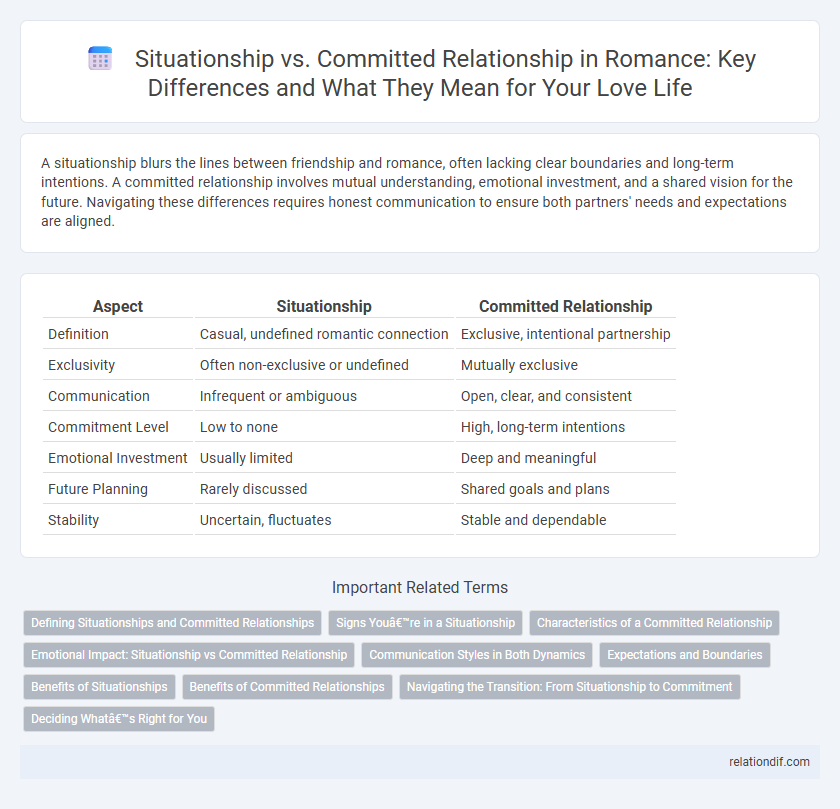A situationship blurs the lines between friendship and romance, often lacking clear boundaries and long-term intentions. A committed relationship involves mutual understanding, emotional investment, and a shared vision for the future. Navigating these differences requires honest communication to ensure both partners' needs and expectations are aligned.
Table of Comparison
| Aspect | Situationship | Committed Relationship |
|---|---|---|
| Definition | Casual, undefined romantic connection | Exclusive, intentional partnership |
| Exclusivity | Often non-exclusive or undefined | Mutually exclusive |
| Communication | Infrequent or ambiguous | Open, clear, and consistent |
| Commitment Level | Low to none | High, long-term intentions |
| Emotional Investment | Usually limited | Deep and meaningful |
| Future Planning | Rarely discussed | Shared goals and plans |
| Stability | Uncertain, fluctuates | Stable and dependable |
Defining Situationships and Committed Relationships
Situationships are undefined romantic connections characterized by a lack of explicit commitment, often leading to ambiguity in emotional expectations and future planning. Committed relationships involve mutual agreements, clear boundaries, and shared long-term goals, fostering trust and stability between partners. Understanding these distinctions helps individuals navigate emotional needs and relationship dynamics effectively.
Signs You’re in a Situationship
Frequent lack of clear labels and inconsistent communication are key signs you're in a situationship rather than a committed relationship. Emotional availability often feels limited, with one or both partners avoiding defining the relationship or making future plans together. Physical intimacy may be present, but without mutual agreement on exclusivity or long-term intentions, signaling a casual, undefined connection.
Characteristics of a Committed Relationship
A committed relationship is characterized by mutual trust, clear communication, and a shared vision for the future, establishing emotional security and stability between partners. Partners in committed relationships often prioritize each other's needs, demonstrate consistent support, and maintain exclusivity to deepen intimacy. Regular expressions of love, long-term planning, and conflict resolution skills further distinguish committed relationships from situationships.
Emotional Impact: Situationship vs Committed Relationship
Situationships often lead to emotional uncertainty, causing stress and anxiety due to lack of clear boundaries and future expectations. Committed relationships provide emotional stability, fostering trust, security, and deeper emotional connection through consistent communication and mutual support. The emotional impact of commitment generally results in greater satisfaction and reduced feelings of loneliness compared to the ambiguity experienced in situationships.
Communication Styles in Both Dynamics
Situationships often feature ambiguous communication patterns, where intentions and expectations remain unspoken, leading to frequent misunderstandings and emotional uncertainty. In contrast, committed relationships prioritize clear, consistent dialogue with explicit discussions about feelings, goals, and boundaries, fostering trust and mutual understanding. Effective communication in commitments includes active listening, openness, and reassurance, which are typically less prevalent in situationships.
Expectations and Boundaries
Situationships often involve unclear expectations and fluid boundaries, leading to potential misunderstandings and emotional ambiguity. Committed relationships typically establish defined boundaries and mutual expectations, fostering trust and security. Clear communication about needs and limits is crucial in distinguishing the emotional investment between situationships and committed partnerships.
Benefits of Situationships
Situationships offer flexibility and low pressure, allowing partners to explore emotional and physical connection without the expectations tied to commitment. They enable individuals to maintain personal freedom while experiencing companionship and intimacy, often reducing stress and enhancing spontaneity. This arrangement suits those prioritizing personal growth or uncertain about long-term intentions, providing a convenient balance between independence and closeness.
Benefits of Committed Relationships
Committed relationships foster emotional security and deeper trust, promoting long-term stability and mutual support. Couples in committed partnerships often experience improved communication and greater intimacy, which enhance overall relationship satisfaction. The clear boundaries and shared goals in committed relationships contribute to healthier conflict resolution and personal growth.
Navigating the Transition: From Situationship to Commitment
Navigating the transition from a situationship to a committed relationship requires clear communication about expectations and boundaries to avoid misunderstandings. Recognizing the emotional investment and mutual intentions helps both partners evaluate compatibility and readiness for exclusivity. Establishing trust and consistent commitment signals a shift from ambiguity to a defined partnership, fostering deeper intimacy and long-term connection.
Deciding What’s Right for You
Evaluating your emotional needs and long-term goals is crucial when choosing between a situationship and a committed relationship. Situationships often offer flexibility but can lack clarity and future security, whereas committed relationships provide stability and mutual understanding. Prioritize open communication and self-awareness to determine which dynamic aligns best with your personal values and romantic expectations.
situationship vs committed relationship Infographic

 relationdif.com
relationdif.com